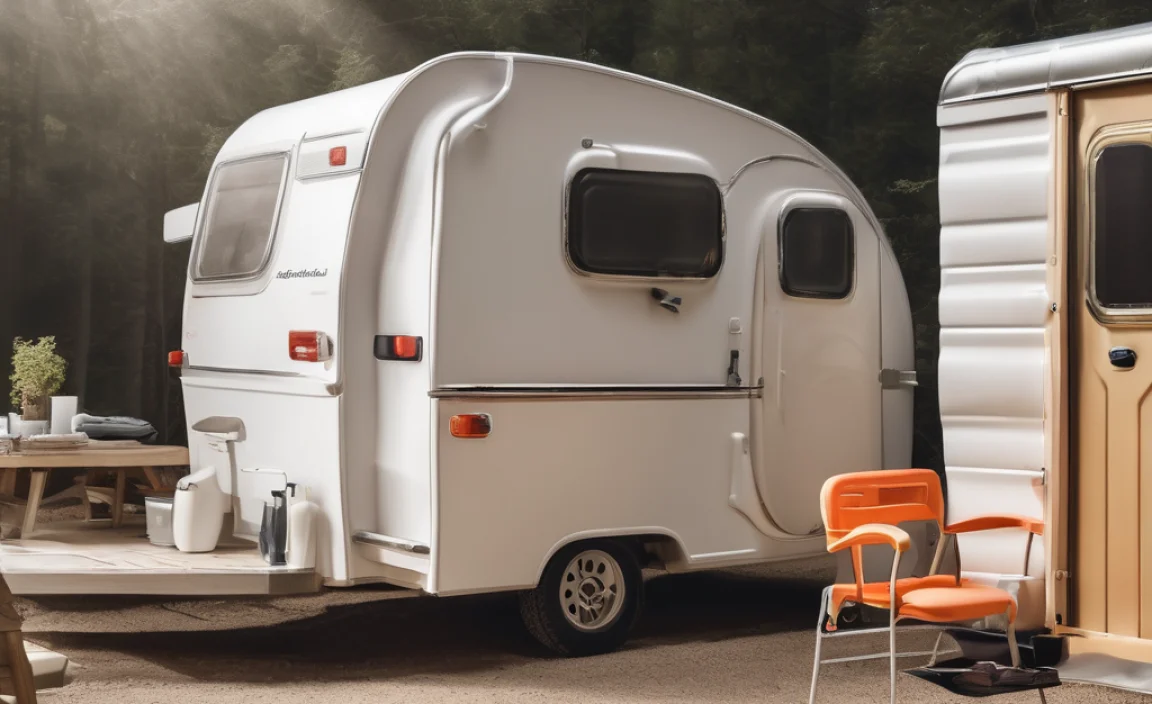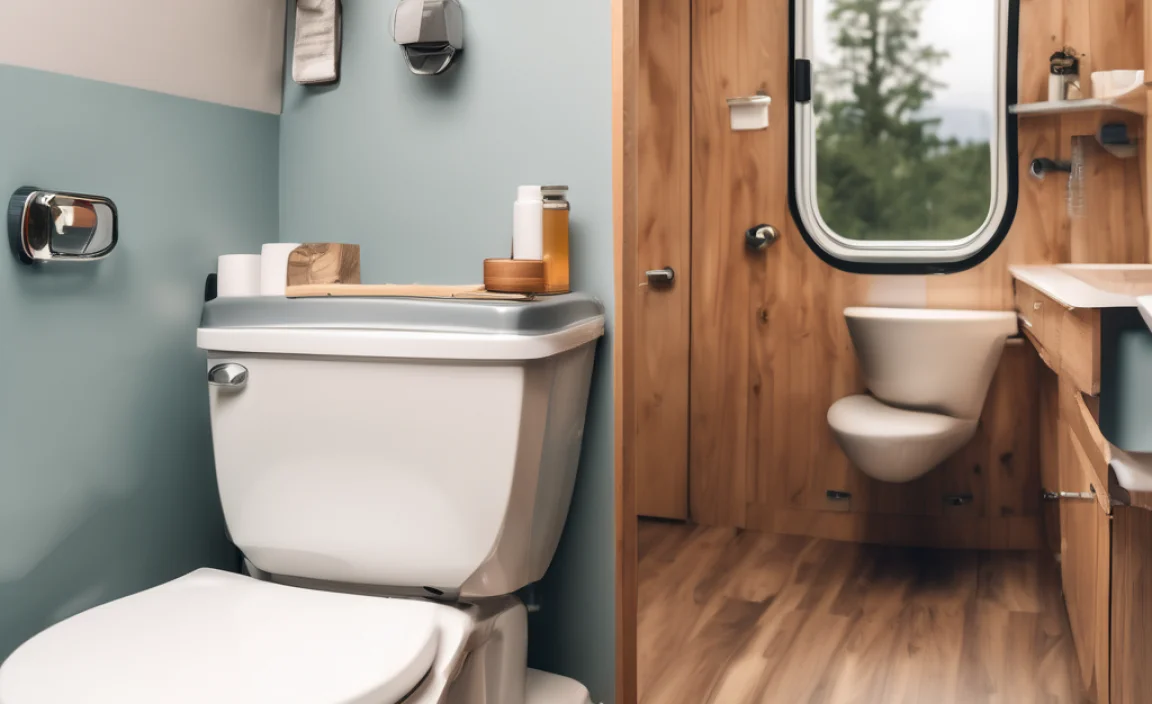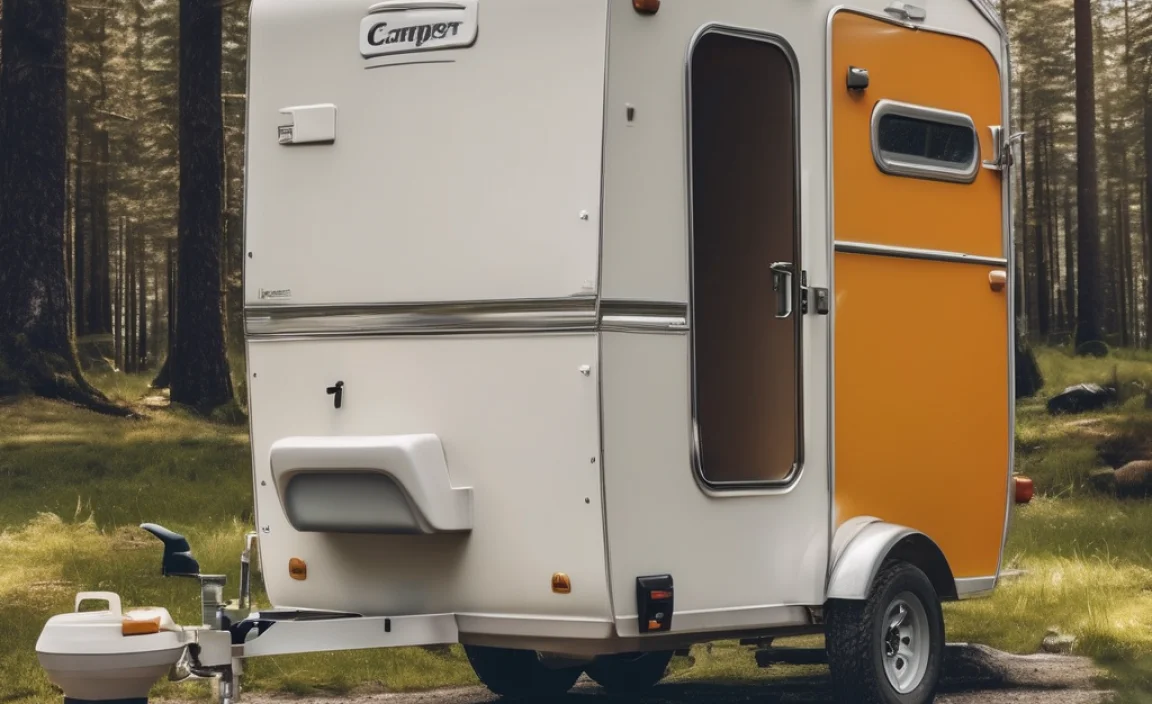Quick Summary: Camper toilets work by storing waste in a holding tank until it can be emptied. Most use a flushing mechanism with a small amount of water and chemicals to control odors and break down waste. Regular maintenance, including emptying and cleaning, is key to keeping your camper toilet sanitary and functional.
Ever wondered how those toilets in campers and RVs actually work? It might seem a bit mysterious, but it’s really quite simple. Camper toilets are designed to be compact and efficient, so they handle waste without needing a full-fledged plumbing system. It’s a common concern for new RVers, but don’t worry—it’s easier than you think to manage.
In this guide, we’ll break down the different types of camper toilets and how each one functions. We’ll also cover essential maintenance tips to keep everything clean and running smoothly. Ready to become a pro at camper toilet operation? Let’s dive in!
Types of Camper Toilets

There are several types of camper toilets, each with its own way of handling waste. Knowing the differences will help you choose the best option for your needs.
Gravity Flush Toilets
Gravity flush toilets are the most common type found in RVs. They work much like the toilets in your home, using gravity to move waste into a holding tank.
How They Work:
- Flushing: When you flush, a valve opens, allowing water from the RV’s fresh water tank to flow into the bowl. This water, along with gravity, pushes the waste down into the black water tank.
- Black Water Tank: The black water tank is a dedicated holding tank for sewage. It’s usually located underneath the RV.
- Odor Control: Chemicals are added to the black water tank to break down waste and control odors.
Pros and Cons:
| Pros | Cons |
|---|---|
| Simple to use | Requires a large black water tank |
| Similar to home toilets | Can use a lot of water |
| Easy to maintain | Potential for odors if not maintained properly |
Cassette Toilets
Cassette toilets are popular in smaller campers and vans. They have a portable holding tank, making them easy to empty.
How They Work:
- Self-Contained: The toilet has its own small water tank and a removable waste tank (the cassette).
- Flushing: A manual or electric pump is used to flush water into the bowl, pushing waste into the cassette.
- Emptying: The cassette can be detached and carried to a dump station or regular toilet for emptying.
Pros and Cons:
| Pros | Cons |
|---|---|
| Portable and easy to empty | Smaller capacity |
| Good for small spaces | Requires manual emptying |
| Less water usage | Can be messy if not handled carefully |
Composting Toilets
Composting toilets are an eco-friendly option that doesn’t use water. They separate solids and liquids to compost the solid waste.
How They Work:
- Separation: Urine is diverted to a separate container, while solid waste goes into a composting chamber.
- Composting: Solid waste is mixed with a bulking agent like peat moss or coconut coir to aid decomposition.
- Odor Control: A ventilation system helps to keep odors at bay and promotes aerobic decomposition.
- Emptying: The composted waste is removed periodically and can be disposed of in an appropriate manner.
Pros and Cons:
| Pros | Cons |
|---|---|
| Eco-friendly and waterless | Higher initial cost |
| Reduces odor | Requires more maintenance |
| Waste can be composted | Can be complex to set up |
Macerating Toilets
Macerating toilets use a grinder to break down waste before it enters the holding tank. This prevents clogs and makes emptying easier.
How They Work:
- Grinding: A built-in macerator grinds solid waste into a slurry.
- Flushing: The slurry is then pumped into the black water tank.
- Clog Prevention: The grinding action prevents clogs and makes the waste easier to manage.
Pros and Cons:
| Pros | Cons |
|---|---|
| Reduces clogs | More complex system |
| Easier to empty tank | Requires electricity |
| Good for long-term use | Can be noisy |
Understanding the Components of a Camper Toilet

Knowing the parts of your camper toilet can help you troubleshoot issues and maintain it properly.
- Toilet Bowl: The basin where waste is deposited.
- Flushing Mechanism: The system that introduces water into the bowl to flush waste.
- Seal: A rubber or plastic seal that prevents odors from escaping the black water tank.
- Black Water Tank: The holding tank for sewage.
- Odor Control System: Chemicals or ventilation systems that minimize odors.
Step-by-Step Guide to Using a Camper Toilet

Using a camper toilet is straightforward, but here’s a detailed guide to ensure everything goes smoothly.
Step 1: Prepare the Toilet
- Add Water: Before using the toilet, add a small amount of water to the bowl. This helps to prevent waste from sticking.
- Add Chemicals: Pour RV-specific toilet chemicals into the bowl. These chemicals break down waste and control odors. Always follow the manufacturer’s instructions for dosage.
Step 2: Use the Toilet
- Use as Normal: Use the toilet as you would at home.
- Conserve Water: Be mindful of water usage, especially if you have a limited fresh water supply.
- Avoid Non-Flushable Items: Never flush anything other than toilet paper designed for RVs. Regular toilet paper, feminine hygiene products, and other items can clog the system.
Step 3: Flush the Toilet
- Flush Thoroughly: After use, flush the toilet to move waste into the black water tank.
- Add More Water if Needed: If waste doesn’t clear completely, add more water and flush again.
Step 4: Monitor the Tank Level
- Check the Monitor: Most RVs have a monitor panel that shows the levels of the fresh water, gray water, and black water tanks.
- Empty When Full: Empty the black water tank when it reaches about two-thirds full to prevent odors and potential damage.
Essential Maintenance Tips for Camper Toilets

Proper maintenance is crucial for keeping your camper toilet clean, functional, and odor-free.
Regular Cleaning
- Bowl Cleaning: Clean the toilet bowl regularly with a toilet brush and RV-friendly cleaner.
- Seal Maintenance: Keep the toilet seal clean and lubricated to prevent leaks and odors. You can use a silicone-based lubricant.
Tank Treatment
- Chemicals: Use RV-specific toilet chemicals to break down waste and control odors. There are various types, including liquids, tablets, and powders.
- Enzyme Treatments: Consider using enzyme-based treatments, which are more environmentally friendly and help to break down waste naturally.
Emptying the Black Water Tank
- Use Proper Gear: Wear gloves and eye protection when emptying the black water tank.
- Connect the Hose: Connect a sewer hose to the RV’s waste outlet and the dump station inlet.
- Empty the Tank: Open the black water tank valve first, followed by the gray water tank valve. The gray water helps to flush out the sewer hose.
- Rinse the Tank: After emptying, rinse the black water tank with a built-in tank rinser or a separate hose. This removes any remaining waste and prevents buildup.
Preventing Clogs
- Use RV Toilet Paper: Only use toilet paper that is designed for RVs. It breaks down more easily and prevents clogs.
- Avoid Flushing Solids: Never flush feminine hygiene products, paper towels, or other solid items.
- Tank Cleaning: Periodically clean the black water tank with a tank cleaner to remove buildup and prevent clogs.
Winterizing Your Camper Toilet
If you live in an area with freezing temperatures, it’s important to winterize your camper toilet to prevent damage.
- Drain the System: Drain all water from the toilet and holding tanks.
- Add Antifreeze: Pour RV antifreeze into the toilet bowl and flush it through the system to protect the pipes and tanks from freezing.
Troubleshooting Common Issues

Even with regular maintenance, you might encounter some common issues with your camper toilet. Here’s how to troubleshoot them.
Odors
- Cause: Odors can be caused by a buildup of waste in the black water tank, a dry toilet seal, or inadequate ventilation.
- Solution:
- Empty and rinse the black water tank regularly.
- Ensure the toilet seal is clean and lubricated.
- Use RV-specific toilet chemicals or enzyme treatments.
- Check the ventilation system for blockages.
Clogs
- Cause: Clogs are often caused by flushing non-flushable items or a buildup of solid waste.
- Solution:
- Use a toilet plunger to dislodge the clog.
- Try a tank cleaner to break down the clog.
- In severe cases, you may need to use a sewer hose with a backflushing attachment to clear the clog.
Leaks
- Cause: Leaks can occur around the toilet seal, the water lines, or the black water tank.
- Solution:
- Inspect the toilet seal for damage and replace if necessary.
- Check the water lines for loose connections or cracks.
- Examine the black water tank for any signs of damage and repair or replace as needed.
Choosing the Right Toilet Chemicals
Selecting the right toilet chemicals is essential for odor control and waste breakdown. Here are some popular options:
- Liquid Chemicals: Easy to pour and dissolve quickly.
- Tablet Chemicals: Convenient and pre-measured for easy use.
- Powder Chemicals: Can be more concentrated and effective for odor control.
- Enzyme Treatments: Environmentally friendly and break down waste naturally.
When choosing chemicals, consider the size of your black water tank, the frequency of use, and your personal preferences.
Grey Water vs. Black Water
Understanding the difference between grey water and black water is important for proper waste management in your camper.
- Black Water: Wastewater from the toilet, containing sewage and toilet chemicals.
- Grey Water: Wastewater from sinks, showers, and washing machines.
Black water requires more careful handling due to its potential health risks. Always dispose of black water at designated dump stations. Grey water can sometimes be disposed of more freely, but check local regulations.
FAQ About Camper Toilets
Here are some frequently asked questions to help you better understand camper toilets.
Q: Can I use regular toilet paper in a camper toilet?
A: No, regular toilet paper doesn’t break down easily and can clog your system. Use RV-specific toilet paper that is designed to dissolve quickly.
Q: How often should I empty my black water tank?
A: Empty your black water tank when it’s about two-thirds full. This prevents odors and potential damage.
Q: What chemicals should I use in my camper toilet?
A: Use RV-specific toilet chemicals that break down waste and control odors. Options include liquids, tablets, powders, and enzyme treatments.
Q: How do I prevent odors in my camper toilet?
A: Regularly empty and rinse the black water tank, use RV toilet chemicals, and ensure the toilet seal is clean and lubricated.
Q: Can I dump my black water tank anywhere?
A: No, always dump your black water tank at designated dump stations to avoid environmental contamination and legal issues.
Q: What is a cassette toilet?
A: A cassette toilet is a portable toilet with a removable waste tank, making it easy to empty. It’s popular in smaller campers and vans.
Q: How do I winterize my camper toilet?
A: Drain all water from the toilet and holding tanks, then pour RV antifreeze into the toilet bowl and flush it through the system.
Conclusion
Understanding how camper toilets work doesn’t have to be daunting. With the right knowledge and regular maintenance, you can keep your RV’s toilet system clean, functional, and odor-free. From choosing the right type of toilet to using appropriate chemicals and practicing proper emptying procedures, you’re now equipped with the essentials. Remember, a little care goes a long way in ensuring a comfortable and enjoyable RV experience. Happy camping!

